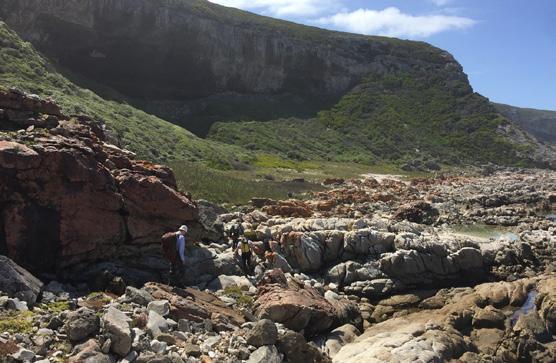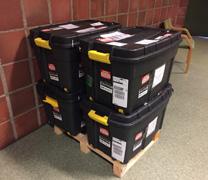
3 minute read
Collecting stalagmites from Bloukrans Cave
In early March 2020, a group of four SapienCE researchers went to the De Hoop Nature Reserve in the Western Cape of South Africa, to collect stalagmites from Bloukrans Cave. These stalagmites contain long, highly detailed records of ancient changes in temperature, rainfall and vegetation.
Although Bloukrans Cave isn’t an archaeological site, it is close to the excavations at Klipdrift and Blombos, so the information preserved in the stalagmites will help the SapienCE team to understand the climate and landscape experienced by our ancestors. This wasn’t our first trip to Bloukrans. In February 2018 we took small test samples from a number of stalagmites. Analysis of these samples by Stein-Erik Lauritzen, Nele Meckler and Jenny Maccali showed that they contained good climate records, and one particular stalagmite called “BL18-01” covered exactly the time period that SapienCE is interested in. By the end of the week BL18-01 would have another name: Stalzilla!
INTO THE DARK
The entrance to Bloukrans is a small hole at the foot of a cliff. Once inside, daylight fades quickly as you descend a long steep slope of sand and bat guano to reach the cave floor. Here it is pitch black, but noisy, with the dripping of water and screech of a thousand bats. Playing the light of your head-torch around the cave reveals a hundred stalagmites and stalactites and the occasional low-flying bat. BL18-01 stood on the sandy slope just above the cave floor. Impressive certainly, but not massive. Our jobs for the week were twofold. Firstly, we wanted to take a number of small samples from around the cave. Dating these samples, together with material collected in 2018, will give us a picture of when the cave was wet enough to produce



speleothems (the collective name for stalagmites and stalactites). Since speleothems are produced by constant dripping water, prolonged dry periods cause formation to stop. Consequently, gaps in the record from BL18-01 may represent either periods of drier climate, or periods where the drip forming the stalagmite moved elsewhere. Dating the small test samples will allow us to determine which of these scenarios occurred, and is critical for understanding the climate record from BL18-01. Our second task, of course, was to remove BL18-01 from the cave.
STALZILLA
Exploring the cave and building a collection of small test samples took up most of the first day at Bloukrans. BL1801 is more than 2 m long, and made from strong, dense calcite. Removing it from the cave took two further days of drilling and hammering, breaking it up into portable pieces and carefully labelling each. The walk from Bloukrans to where we were able to park our vehicle takes about an hour and involves a strenuous climb up the very steep coastal cliff, and several sections through thorny undergrowth. This is tricky enough without a heavy piece of stalagmite in your backpack. On the evening of the third day, we had removed less than half of BL18-01, but the news from the outside world was clearly bad. On the fourth day we made extra effort, overloaded our backpacks with speleothem, and removed the remainder of BL18-01. In total, Stalzilla weighed 170 kg. It was a tough afternoon! That evening we were told to fly home immediately, to avoid being stranded in South Africa by the pandemic. Had this happened one day later, we would have been able to retrieve Nele Meckler’s temperature monitor from Klipdrift, our last task for the fieldtrip. One day earlier, and Stalzilla would still be in Bloukrans, rather than in the University of Bergen yielding a vital record of the climate and landscape experienced by our ancestors. Sometimes, science is all about timing!








